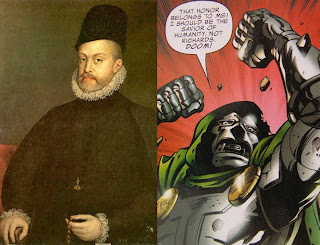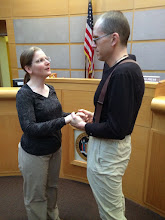
In the recent movie
Iron Man Jeff Bridges' character, industrialist Obadiah Stane, has to deal with an epiphany. He's particularly unhappy because it's a big shiny epiphany that fills the room, and it's not his. Before long Stane will also get big and shiny, and
demolish the room. But we don't know that yet.
Tony Stark has just returned from Afghanistan like a walking
Joseph Campbell lecture. He's watched American soldiers killed by his own weapons. With Stark Industries shrapnel in his chest, he's almost died by his own design. Under the noses of his captors he's built more machines: a miraculous power source, a device to stabilize the shrapnel, and finally a suit of powered combat armor that he uses to break free. Stark has watched his creativity refracted, seen all the colors: death, salvation and everything in between. He's been burned, and doesn't want to bring humanity any more fire. At his word, Stark Enterprises has stopped producing weapons.
Tony's old pal Obadiah is not pleased - and Jeff Bridges does a superlative job here playing a slimy smooth operator. He pretends to have Tony's best interests in mind while trying to bring him back around to his old devil-may-care weaponsmith self. Throughout this performance Stane masks his distress almost perfectly, only losing his cool once. In the midst of his words sliding off Stark's newfound moral exterior, Stane exclaims "We're ironmongers, Tony!"
This caught my attention. I'd always assumed that "Iron Monger", Stane's name for his version of the Iron Man armor, was a made-up word. In the eighties, when Stane appeared in the comic book, it seemed natural to me that a comic book writer would take the Shakespearian word "fishmonger" and tweak it to create a corrupt-sounding version of "Iron Man". But here in the movie Stane was using the word before he even knew about Stark's armor. It seemed to imply that "ironmonger" was not a new construction, so I looked it up. Sure enough, it's been a common enough word for at least six centuries. The word appears eight times in the diary of
Samuel Pepys.
October 23, 1660
...She also took me to her
lodging at an Ironmonger's in King Street, which was but very poor...
November 25, 1662
...Up and to the office all the morning, and at noon with the rest, by Mr. Holy, the ironmonger's invitation, to the Dolphin, to a venison pasty, very good, and rare at this time of the year...
November 28, 1662
...Up and to Ironmongers' Hall by ten o'clock to the funeral of Sir Richard Stayner. Here we were, all the officers of the Navy, and my Lord Sandwich, who did discourse with us about the fishery...
September 7, 1663
...The play being done, I stole from him and hied home, buying several things at the ironmonger's--dogs, tongs, and shovels--for my wife's closett and the rest of my house, and so home, and thence to my office awhile, and so home to supper and to bed.
October 27, 1664
Up and to the office, where all the morning busy. At noon, Sir G. Carteret, Sir J. Minnes, Sir W. Batten, Sir W. Pen, and myself, were treated at the Dolphin by Mr. Foly, the ironmonger, where a good plain dinner...
May 21, 1667
...Mr. Harper at Deptford did himself tell her that my Lord hath had of Foly, the ironmonger, L50 worth in locks and keys for his house...
July 20, 1668
...and so home, and took occasion to buy a rest for my espinette at the ironmonger's by Holborn Conduit...
February 6, 1669
...Thence home, and just at Holborn Conduit the bolt broke, that holds the fore-wheels to the perch, and so the horses went away with them, and left the coachman and us; but being near our coachmaker's, and we staying in a little ironmonger's shop, we were presently supplied with another, and so home, and there to my letters at the office, and so to supper and to bed.
When I think of Pepys's ironmongers I get an impression of skilled craftsman; their cleverness doesn't earn them any particular standing in society, but neither does it bear any moral attachments. I thought this was very interesting, because the word perfectly embodies Stane's side of the moral gulf between him and Stark. If Pepys had beaten his wife with the espinette rest, would the ironmonger at Holborn Conduit be responsible? The notion is laughable. Stane feels the same way about his weapons: he just makes tools that his clients find useful - he's not responsible for what people do with them after they leave the warehouse. Stark used to feel similarly, but not any more.
Thoughts of moral accountability reminded me of Plato's
Republic, which I've been listening to lately. In it the character of Glaucon recounts the legend of Gyges, who discovered a ring that gave him the power to become invisible. Glaucon claims that no man could resist the temptation to abuse such a power, and goes on to assert that all attempts to live a just life are merely part of a selfish social contract - if people could get away with injustice with no fear of punishment, they would. The more I thought of this, the more it seemed like an inversion of Tony Stark's epiphany. Gyges stumbles upon an opportunity for power without accountability, and he lacks the strength to resist. Contrast that with Stark's transfiguration, which gives him both the impetus for his creative act and the strength not to abuse his creation.
I was thinking about moral accountability for one's creations, so I suppose it was inevitable that I'd come around to Mary Shelley's
Frankenstein. This line of thought got more interesting when I thought of the full title:
Frankenstein; or, The Modern Prometheus. There's been a lot written over the centuries about how Shelley's book was the first science fiction story, and about its core theme of the moral ambiguity of technology - which is ultimately beyond the control of the creator. In that sense, Iron Man could not be a more direct descendent of Shelly's novel. Stark is a
Prometheus forever straining toward two opposing
asymptotes: improving the human condition through technology, and maintaining control over technology.
This fascinating article about Luddite influence in
Frankenstein puts Shelley's novel in a historical context. With its emphasis on the concept that Luddites were not against technology, but rather against implementing it in ways that made life worse for people, it also brings me back around to Tony Stark. Another man might have seen the ends for which his weapons were used and sworn off technology. Not Stark. He reacts to his epiphany not only with a surge of fresh creativity, but by imposing moral boundaries on his creations. He is a consummate control freak. That's where his alcoholism comes from, and it's what makes him a hero for an age in which we keep discovering how little we can control. Like Frankenstein, Stark keeps creating. Like Frankenstein, he eventually comes to be defined by his endless chase after his unbound creations.
Along with thoughts of Shelley, my musings brought me back to an association I had when I first listened to
The Republic. Anyone who's read
Tolkien will understand the reaction I had to hearing about the ring of Gyges. I had been drifting a bit, listening to the narrative as I walked. But when Glaucon started talking about a gold ring whose power to make the wearer invisible would tempt even the most virtuous man, little exclamation points appeared over my head as I thought of the
One Ring.
I always feel embarrassed when I discover that an idea I heard from a modern author is actually thousands of years old. I respond to that embarrassment by examining how the idea flowed from the distant source to the twentieth century spigot. I wondered if Tolkien got his idea from Plato, and then a more interesting question came to mind: Do the differences between Plato's story and Tolkien's reflect an evolution of human morality?
At first I thought of how the ring of Gyges was utterly irresistible, and of how
The Lord of the Rings gets a lot of its dramatic tension from the One Ring being
not quite irresistible. A very few mortals could be a Ring-bearer, and I thought this crucial difference represented a conceptual shift over the millennia. Perhaps people, at least in their imaginings of themselves, had gotten better.
Now listen up, because this is a perfect example of how a short attention span like mine can get you into trouble. I have not yet finished
The Republic. I had to take a break around chapter six because I'd had it up to
here with the narrator's plummy tones that so perfectly reflected my growing certainty that Plato was a self-satisfied wankspout. Because I had not yet come to Socrates' conclusions about justice, it was easy for me to forget that the story of the ring of Gyges was
Glaucon's story, not Socrates'. Once I remembered this, I searched the text and found the following in chapter X.
Let a man do what is just, whether he have the ring of Gyges or not, and even if in addition to the ring of Gyges he put on the helmet of Hades.
Plato - through Socrates' dialogue - refutes Glaucon's notions, making a case for personal accountability and individual morality. And again, I hear millenia-old echoes in Frodo Baggins and Tony Stark, two variations on an old theme. In one story the object of power is a ring forged by the Dark Lord Sauron, and Frodo is the only one who can destroy it. In the other story, the object of power changes mercurially: first it's a missile, later a suit of armor. That's because the real prize is knowledge, and
no one can destroy that. Stark is like a snake that constantly eats its own tail while shedding its own skin. He forges one weapon, it burns him, and the pain propels him on his
hero's journey. He comes back changed, with a new weapon, trusting only in himself to use it. But others find a way to steal his new fire, and he must chase it. His Mount Doom is a phoenix. His hero's journey never ends.
Part of me wishes I had something pithy to say about all these connections. I recognize, though, that I'll need a few more years of reading under my belt before I can extract any pith without injuring myself. In the meantime, I'm just going to enjoy hearing the echoes and feeling the pleasant surprise as I recognize themes that have been handed off for so long from mouth to mind. I'll leave you with a quote from
Henry V that would have echoed loudly in Tony Stark's mind.
Every subject's duty is the king's; but every subject's soul is his own. Therefore should every soldier in the wars do as every sick man in his bed, wash every mote out of his conscience: and dying so, death is to him advantage; or not dying, the time was blessedly lost wherein such preparation was gained: and in him that escapes, it were not sin to think that, making God so free an offer, He let him outlive that day to see His greatness and to teach others how they should prepare.
















